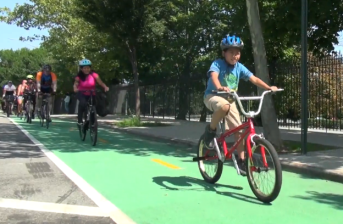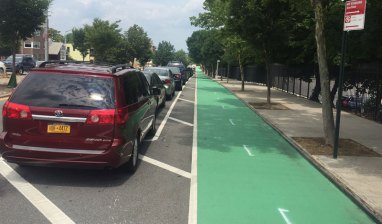Want to Drive Thru Corona to the US Open? Francisco Moya’s Got Your Back

Assembly Member Francisco Moya opposes a DOT plan for safer walking and biking on 111th Street next to Flushing Meadows Corona Park. In a statement, he said it will slow down people driving through the neighborhood he represents on their way to professional baseball games and tennis tournaments.

“111th Street is a high traffic road, which suffers from massive spikes in congestion during the numerous cultural and sporting events in the surrounding area, including Mets games and USTA tournaments,” Moya said in the statement. “There is little doubt that DOT’s proposal to reduce car traffic to one lane will result in slowed traffic and increased congestion, but I am also deeply concerned with the possibility of an increase in accidents and air pollution for the immediately surrounding area.”
DOT studied traffic conditions during five days in April and May, counting cars during a Cinco de Mayo celebration in the park, two Queens Night Markets, and eight Mets games, including this season’s home opener. The agency found the increased traffic was mostly north of the area slated for the road diet and could be ameliorated by adjusting signal timing and keeping traffic bound for Citi Field on the highway [PDF].
“We still don’t feel that that’s sufficient,” said Meghan Tadio, Moya’s chief of staff. “We think that, really, if we’re going to limit the traffic lanes to one lane in each direction, we need to have a full study during the summer months… We would take them and their numbers as reality if they took time to do the study over the whole peak summer.”
The street handles no more than 350 cars in each direction during a typical rush hour, according to DOT, a volume that can easily be handled with a single lane each way.
“It would be insane if we went around designing streets for three or four specific days of the year,” said Transportation Alternatives Queens organizer Jaime Moncayo. “You’re basically inconveniencing the people who use the street year-round for the people who use it two or three times for an event.”
Moya suggested running bike lanes through the park, along the 111th Street median, or on the west side of the street, which intersects with cross streets each block, but DOT rejected his suggestions. Tadio said her boss would be unlikely to support any plan that did not keep at least two car lanes in each direction.
Moya also complained that the city made the proposal “without an adequate community process and without consulting the people it will impact most — the residents from 111th Street and the surrounding neighborhood. They chose to impose a plan on local residents that was not evaluated by the community.”
“His office wasn’t included, he was not included in the process. Staff members we have who live on the street were never door knocked,” Tadio said. “We felt excluded.”
Last year, the Queens Museum, Immigrant Movement International, Make the Road New York, and Transportation Alternatives began working with local residents near 111th Street. In July, the groups hosted a Vision Zero workshop, followed by a daffodil planting in September. Then, Council Member Julissa Ferreras allocated $2.7 million for a street redesign before DOT presented its plan.
“It’s really disingenuous to say that the community hasn’t been contacted,” Moncayo said. “It’s really frustrating to hear that.”
Tadio insisted that Moya wants to see changes to 111th Street. “What the assemblyman is trying to do is be that bridge between the community board members who right now are wary of the complete change to the street, and the folks who want to see this plan go through,” she said. “He’s trying to bring both sides together to find a happy medium.”
The plan is likely to go before CB 4 at its next general board meeting, scheduled for 7 p.m. on June 9 at VFW Post 150, 51-11 108th Street. Moya will be there, Tadio said.
So will supporters of the plan, who are spending tomorrow afternoon on 111th Street gathering signatures for the redesign. “We haven’t had any trouble finding people who think it’s a good idea,” Moncayo said, “so if there’s more time for us to go out there and find people who support it, then we welcome it.”


